Highlights
- The surprisingly large number of Americans reporting one lifetime sex partner have the happiest marriages. Post This
- Premarital sexual experience affects marital happiness, but perhaps the more important story is that almost two-thirds (64%) of Americans are happy in their marriages. Post This
- The difference between having one and more than one lifetime sex partner is most consequential in predicting marital quality. Post This
The 1960s changed premarital sex. Prior to the sexual revolution, unmarried heterosexual sex partners tended to marry each other (sometimes motivated by a shotgun pregnancy); in more recent decades, first sex usually does not lead to marriage. Figure 1 shows how the odds of having only one lifetime sex partner have declined over the twentieth century for married Americans. The biggest declines occurred for people born between the 1920s and the 1940s, the latter of whom came of age during the sexual revolution of the 1960s. Since then, the chances of having only one lifetime sex partner (or, less often, marrying as a virgin) have held steady for married women at around 40%, and have actually inched up for the past couple of cohorts of married men. This is consistent with broader trends in men’s sexual behavior. The 40% figure is similar to what I found using a different data set (the National Survey of Family Growth) for women marrying before the start of the new millennium (the number is somewhat lower for more recent marriages).
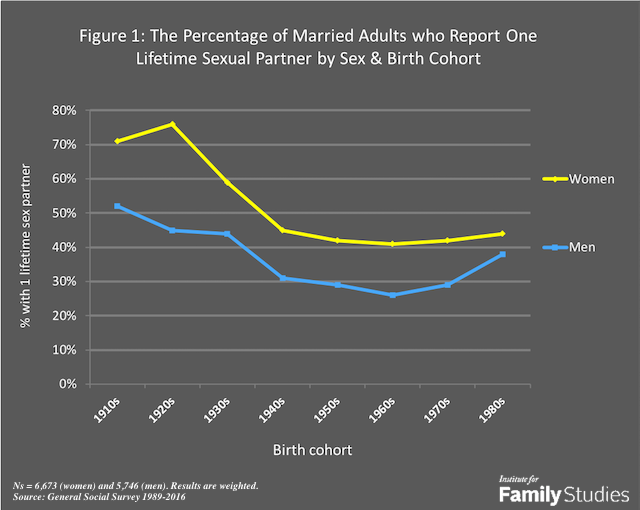
How have our marriages been affected? In an IFS blog post from two years ago, I wrote about the relationship between premarital sex partners and the probability of divorce. Survey respondents who tied the knot as virgins had the lowest divorce rates, but beyond that, the relationship between sexual biography and marital stability was less clear. Having multiple partners generally doesn’t increase the odds of divorce any more than having just a few does so.
The current post extends this research by examining the relationship between premarital sex partners and marital happiness. The obvious prediction for many IFS blog readers may well be that multiple premarital sex partners leads to unhappy marriages, but the relationship probably isn’t that clear-cut. Marital happiness and divorce aren’t always as intertwined as they might seem. A clarifying example is the family demography of the Great Depression. Pervasive financial hardship made marriages less happy, yet the divorce rate fell because divorce and single living seemed unaffordable. A high-conflict but intact family of origin increases the odds of having a disputatious marriage but not the likelihood of divorce. All this research suggests that the effects of one’s premarital sexual biography on marital happiness may not closely follow the findings outlined in my previous post.
Previous research indeed suggests a complex story between premarital sex partners and marital quality. Psychologists Galena K. Rhoades and Scott M. Stanley found that the study respondents who had sex with other people prior to marriage reported lower-quality unions compared to couples who slept just with each other. Multiple sex partners prior to marriage reduced marital quality for women, but not men. Along similar lines, sociologist Jay Teachman showed that premarital sex between future spouses didn’t make divorce more likely, but sex with other people did. A study from the 1980s reported similar findings.
Rhoades and Stanley offer two explanations for this finding, one empirically demonstrable and one speculative. Their data show that premarital sex sometimes leads to premarital fertility, and women (but not men) who have children from other relationships have lower-quality relationships. On the speculative side is their notion that having multiple partners increases awareness of spousal alternatives. It’s evidence for this proposition that the divorce rate increases in regions with more single people; in other words, we’re always willing to consider alternatives to our current mate. By implication, our marriages suffer when we make more comparisons.
What’s missing from these studies is an exploration that considers the effects of a full range of premarital sexual activity on marital happiness using national data. I look at almost 30 years of the General Social Survey, an annual or biennial survey dating back to 1972. Starting in 1989, respondents were asked detailed questions about their sexual biographies.1 My data analysis explores how sexual history affects marital happiness, measured with a variable that contrasts very happy marriages with all others.
Overall, 64% of respondents report very happy marriages (only about 3% say their marriages aren’t too happy; the balance have “pretty happy” unions). Also, most Americans have less exciting sexual histories than the media would lead us to believe. The median American woman born in the 1980s has had three sex partners in her lifetime. The median man has had six partners, but only four if he’s a four-year college graduate.
Table 1 shows how a women’s sexual biography affects the happiness of her marriage.2 The first column includes the baseline estimates. Women who’ve only slept with their spouses are, at 65%, most likely to report very happy marriages. Thereafter, there’s a decline that’s statistically-significant but modest in magnitude. The lowest odds of marital happiness, 52% in the baseline model, accord to women who’ve had six-to-10 lifetime sexual partners. Women who’ve had 11 or more lovers are a bit more likely to report happy marriages at 57 percent.
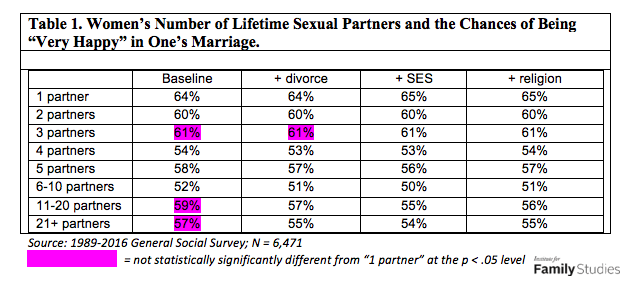
The second, third, and fourth columns of Table 1 introduce a variety of covariates intended to account for the relationship between sexual history and marital happiness. The second column includes a measure of whether survey respondents have dissolved previous marriages; in other words, whether or they’re in first or higher order marriages. The third column adds two measures of socioeconomic status, education and inflation-adjusted family income. The fourth column contains two measures of religiosity, denomination and frequent church attendance. None of these variables has an appreciable effect on the relationship between sexual background and marital happiness.
Table 2 shows how men’s sexual biographies affect their marital happiness. As for women, men who report only one sexual partner in their lifetime are more likely to report very happy marriages. The benefits of one partner are slightly greater for men than for women: according to the baseline results, 71% of men with one partner are very happy in their relationship. This drops to 65% for men who report two or more sex partners. The happiness penalty for additional partners is modest, only a few percentage points. Adjusting for differences in marital history, socioeconomic status, and religion make little difference.
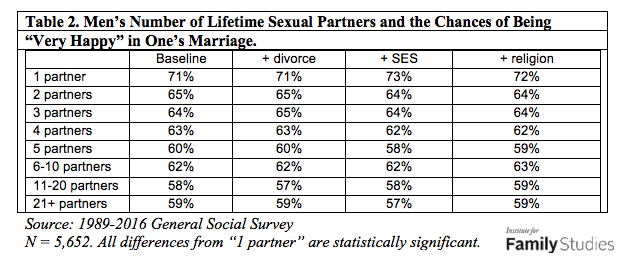
To better visualize the results in Table 1, I’ve taken the percentages from the full models for men and women—the models including controls for marital background, socioeconomic status, and religion—and plotted them together in Figure 1. This figure makes clear that the difference between having one and more than one, lifetime sex partner is most consequential in predicting marital quality. For men, there aren’t statistically significant differences in marital quality between men who have two partners and more than two. That is the trend for women too, with two exceptions: female respondents with four partners or 6-10 partners have significantly lower odds of very happy marriages compared to those with two partners. It’s not clear why these two groups of women defy the broader trend, but it should be noted that the percentage differences involved aren’t great.
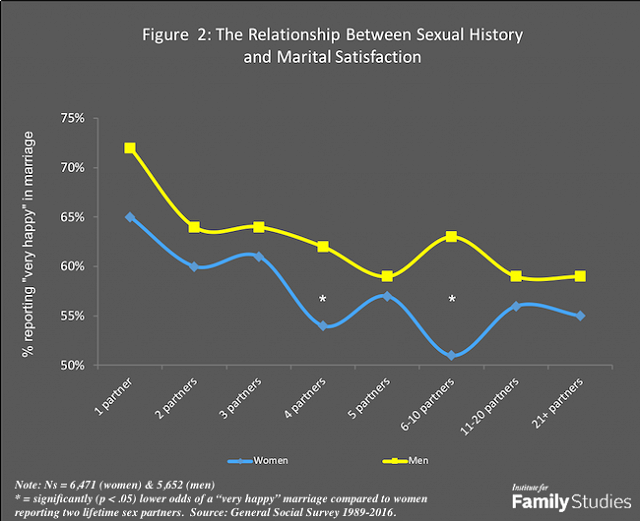
Who are these Americans reporting just one lifetime sex partner? They are likely different from their fellows in ways that predict both premarital sexual behavior and marital happiness. Religiosity is an obvious answer, but that doesn’t seem to accord with the data. Denomination and attendance at services do not fully capture religious beliefs and behavior, but we’d still expect these measures to account for part of the association between sexual behavior and marital quality. But that didn’t turn out to be the case, which leads me to question the importance of religion in explaining the happiness of one-partner spouses.
Perhaps genetics can explain the relationship between sexual biographies and marital happiness. Scientists have identified a gene associated with promiscuity and infidelity. And it’s long been known that there’s a purely genetic component to divorce. Maybe it’s some socially determined personality trait. Whatever the cause, it leads people to behave in ways that aren’t conducive to connubial bliss, with adultery being the most obvious and extreme example. Any of these explanations are possible, but none can be identified with these data.
One thing missing from the foregoing results is any direct consideration of whether marriage age affects the association between multiple sexual partners and marital happiness. It’s not part of the data analysis because the General Social Survey only queried respondents about marriage age through 1994, and one more time in 2006. Other things being equal, older respondents have had more time to accumulate extensive sexual histories. And while they generally enjoy more stable marriages than do people who marry young, their marriages are somewhat less happy.
To determine whether marriage age is affecting the results, I reran my analysis just for the GSS years that include data on both age at marriage and sexual history (1989-1994, 2006). For purposes of comparison, I also ran the analysis without marriage age to determine the extent to which it could explain the relationship between sexual history and marital happiness.
For both men and women, the baseline models in Table 3 include all the independent variables listed in Tables 1 and 2.3 The subsequent columns include age at marriage (and its square). Overall, Table 3 suggests that adding marriage age to the analysis makes essentially no difference, so it cannot explain the relationship between sexual background and marital quality.
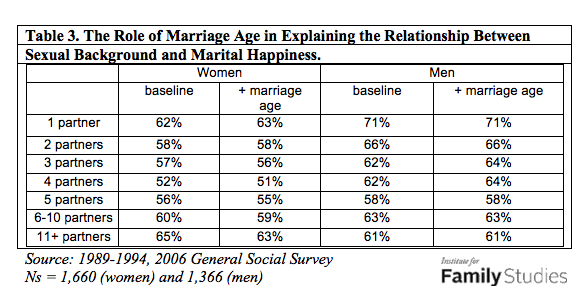
As noted previously, 3% of the married GSS sample reports being unhappily married. The data show that people with 21 or more partners lifetime are almost twice as likely to be unhappily married as are people with fewer partners: 5.3% of respondents with 21+ partners aren’t happy in their marriages, compared to 2.8% of those with 20 or fewer partners. This sexually adventurous minority is explaining part of the relationship between sexual biography and marital happiness (and they’re less likely to be married in the first place) in conjunction with the happiness boost that corresponds with limiting premarital relations to one’s future spouse.
Some caveats. First, data on sexual partners are likely prone to errors of boastfulness, shame, and memory (consider, for instance, the married respondents claiming zero lifetime sex partners). For these errors to affect the results, they’d have to be systematically correlated with marital happiness, and there’s no prima facie reason to expect that.
Second, data on sex partners and marital happiness are measured at the same point in time. It’s reasonable to assume that the partners preceded marriage in most cases, but in a few instances, they represent adulterous trysts or polyamorous unions. Adultery is both a cause and a consequence of a deteriorating marriage.
Third, a measure of marital happiness with two or three categories is obviously a blunt psychometric instrument. As I suggested earlier in discussing the relationship between marital happiness and divorce, a lot more factors into whether a marriage is good. For instance, one study found that people from divorced families of origin had marriages that were just as happy as unions between people from intact families, yet the former were more likely to think their marriage was in trouble. A person’s sexual history might affect marital happiness in ways that are similarly more complex than can be captured with a single variable.
Finally, there are obvious reasons to expect sample selection bias to affect the results. People who are promiscuous before marriage sometimes don’t stop once they tie the knot, and adultery leads to unhappy marriages and divorce. So, the people most at risk of being in unhappy marriages by virtue of their complicated sexual histories may no longer be represented in the sample of people reporting on the happiness of their marriages. This bias would minimize the effects of premarital promiscuity on marital quality.
In sum, the surprisingly large number of Americans reporting one lifetime sex partner have the happiest marriages. Past one partner, it doesn’t make as much of a difference. The overall disparity isn’t huge, but neither is it trivial.
Consider how the difference in marital happiness based on lifetime sex partners stacks up against differences based on several of the usual social and demographic suspects.4 For a combined sample of men and women, spouses reporting only one lifetime sexual partner are 7% more likely to be happy than are those with other partners in their past.
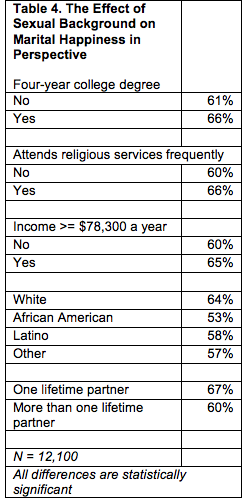
This is larger than the five-percentage-point difference associated with a four-year college degree, larger than the six-point difference that comes with attending religious services several times a month or more, and larger than the boost that comes with having an income above the national median.5 On the other hand, the one-partner difference is smaller than racial-ethnic disparities in marital happiness.
Premarital sexual experience affects marital happiness, but perhaps the more important story in these data is that almost two-thirds (64%) of Americans are happy in their marriages.
Nicholas H. Wolfinger is Professor of Family and Consumer Studies and Adjunct Professor of Sociology at the University of Utah. His most recent book is Soul Mates: Religion, Sex, Children, and Marriage among African Americans and Latinos, coauthored with W. Bradford Wilcox (Oxford University Press, 2016). Follow him on Twitter at @NickWolfinger.
1. My analysis ignores sexual orientation. Partners can be of either sex; same-sex marriages are included in the tally of marital satisfaction. There are too few gay and lesbian marriages to permit separate analysis. Seven percent of married women and 9 percent of married men claimed zero lifetime sexual partners. Presumably, these respondents misinterpreted the survey question as inquiring about former sex partners. These respondents are treated as having had one sex partner.
2. These results are based on regression standardization of logistic regression results. The baseline model includes measures of survey year, age and its square, race/ethnicity, and family structure of origin (Here and elsewhere, functional form was ascertained via lowess models.) The data are weighted to make the sample nationally representative. Standard errors are adjusted for the weight scheme and design effects.
3. Number of sex partners is top-coded at 10+ for this analysis because of sample size limitations: 24 female respondents reported having 11 to 20 partners; 17 reported 21 or more sex partners. The ensuing results were nonsensical.
4. These analyses are based on men and women, and are similar to those reported in Table 1, and contain all of the covariates in the full models.
5. Inflation-adjusted income is originally reported in 1987 dollars. I converted to 2016 dollars using the Consumer Price Index and rounded.













